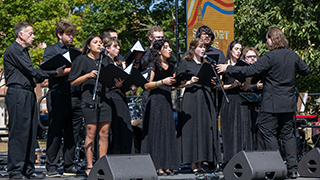Data Science Club Working Toward More Efficient Future - Seton Hall University
Wednesday, March 8, 2017

The Data Science Club is three weeks old and has already laid out plans for two major coding projects, the first of which centers on a self-driving car named Joanna. The club's vice president, Joshua Steier, a junior, built and programmed Joanna last November and after the formation of the club, suggested it as a group project.
The miniature vehicle is programmed to move forward and stops only when her color sensor sees red. Receiving the commands is a mini-computer in the form of a circuit board the size of a pop tart called a raspberry pi. Steier claims it can act as the brain and the heart of the robot. "It is the brain, and the electronic wires are like the nerves of the robot," the mathematics major said. "It's also a heart because it provides most of the power."
The self-driving car project was inspired by Stanford University, which built an autonomous car nicknamed Stanley, the Data Science Club president added.
"The way it works is through software that interprets sensor data (and) allows the car to execute navigation decisions," the marketing major said in an email. "This software was written in the programming language Python, which is used for many applications in the sciences, mathematics, machine learning and artificial intelligence."
The club meets in TLTC Maker Space, on the first floor of the library, every Monday from 8-9 p.m. working toward two goals: a self-driving car and a flying robot, built from a 3-D printer.
"We're at the planning stage," Steier said. "We're trying to program the driverless car while teaching Python. We're also building the car simultaneously."
Such processes take skills in mathematics, engineering and programming. Since these programs take time to understand and apply the car's estimated time of completion is fall 2017.
The club filled its roster with more than 90 students, many of them freshmen. The club president and Steier are focused on helping students achieve their goals, whatever those may be. Steier said they stress the importance of employability to students. One of their aims is to help all members, of any major, get jobs and make connections.
Freshman Sean King is learning coding for the first time and has not missed a meeting. He uses the hour-long meetings every Monday to learn Python and works through practice problems on an online program throughout the week.
"Google's working on this," King said. "It's not an easy thing."
The club has provided a creative outlet for King, proposing a better fit in computer science than his current major of physics and engineering.
"Coding is actually simple, it's just not easy," according to King.
This article first appeared in a recent issue of the Setonian.






